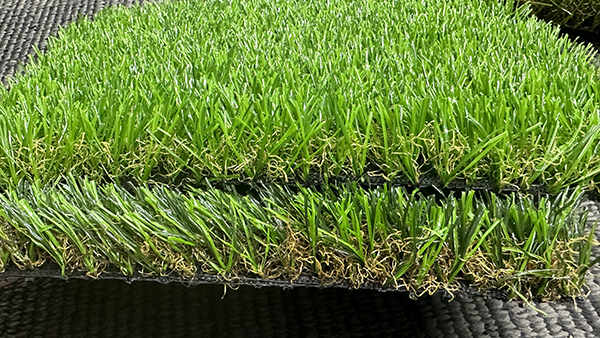
Artificial Grass Backing and Adhesive Types for Various Grass Styles
Artificial Grass Backing and Adhesive Types for Various Grass Styles
The backing system and adhesive are critical components of artificial grass, as they provide stability, durability, and structural integrity. Different grass types—such as landscape grass, sports grass, pet turf, and mini grass—utilize specific backing materials and adhesives tailored to their purposes. Below is a detailed analysis of the various backing types and adhesive classifications for artificial grass.
- Primary Purpose: Aesthetic and decorative use in residential and commercial landscapes.
Backing Composition
1. Primary Backing:
- They're usually made of polypropylene (PP) or polyester, which are great materials!
- Woven or non-woven structure to hold the fibers in place during tufting.
- Provides flexibility and allows for uniform tufting.
2. Secondary Backing:
- Made from high-quality materials like latex or polyurethane (PU), ensuring top-notch performance and durability.
- Boosts the grass's dimensional stability and durability for a strong, reliable foundation.
Adhesive Types
1. Latex Adhesive:
- The most common adhesive for landscape grass.
- Provides sufficient bonding strength for light-to-moderate usage.
- Cost-effective and flexible, ideal for areas with minimal wear and tear.
2. PU Adhesive:
- Used in premium landscape grass for improved durability.
- Boasts enhanced water resistance compared to latex, making it a reliable choice for various applications.
2. Sports Turf
- Primary Purpose: High-performance surfaces for sports such as soccer, rugby, hockey, and tennis.
Backing Composition
1. Primary Backing:
- Dual-layer polypropylene (PP) material.
- Designed to withstand high impact and maintain fiber stability under heavy use.
2. Secondary Backing:
- PU backing is preferred for its superior durability, flexibility, and resistance to environmental stress.
- Some sports turf may use thermoplastic elastomer (TPE) for added strength.
Adhesive Types
1. Polyurethane (PU) Adhesive:
- Offers excellent fiber bonding strength and resistance to temperature fluctuations.
- Common in fields with high-performance requirements.
2. Hot-Melt Adhesive:
- Used in some advanced sports turf systems for quick and efficient bonding.
3.Pet Turf
- Primary Purpose: Specially designed for pets, focusing on durability, odor resistance, and ease of cleaning.
Backing Composition
1. Primary Backing:
- Permeable polypropylene (PP) or polyethylene (PE) material.
- Ensures proper drainage for liquid waste, keeping things running smoothly.
2. Secondary Backing:
- Perforated PU or latex backing to enhance drainage capability.
- Reduces odor buildup by allowing liquids to flow through.
Adhesive Types
1. PU Adhesive:
- Preferred for pet turf due to its water resistance and durability.
- Prevents delamination even with frequent cleaning.
2. Antibacterial Coating:
- Some pet turf uses adhesives with antibacterial properties to combat odor and bacteria growth.
4. Commercial Grass (Short-Pile Grass)
- Primary Purpose: Used for decorative applications, events, and small-scale indoor or outdoor installations.
Backing Composition
1. Primary Backing:
- Thin polyester or polypropylene (PP) material.
- Lightweight and flexible, suited for temporary setups.
2. Secondary Backing:
- Latex backing is the perfect choice for those looking to save money!
- Thinner and lighter than backings for other grass types.
Adhesive Types
1. Latex Adhesive:
- Affordable and adequate for lightweight grass.
- Suitable for low-traffic areas and temporary use.
2. PU Adhesive:
- Used in premium mini grass for longer-lasting performance.
Comparison Table of Backing and Adhesive Types
| Grass Type |
Primary Backing |
Secondary Backing |
Adhesive Type |
Key Features |
| Landscape Grass |
PP or polyester |
Latex or PU |
Latex (common), PU (premium) |
Flexible, cost-effective, suitable for decorative use |
| Sports Turf |
Dual-layer PP |
PU or TPE |
PU, hot-melt adhesive |
High durability, impact-resistant, withstands heavy usage |
| Pet Turf |
Permeable PP or PE |
Perforated PU or latex |
PU, antibacterial adhesive |
Odor-resistant, excellent drainage, easy to clean |
| Mini Grass |
Polyester or thin PP |
Latex |
Latex (common), PU (premium) |
Lightweight, flexible, ideal for temporary or decorative setups |
Explanation of Key Terms
1. Primary Backing:
- The initial layer where grass fibers are tufted. It ensures proper alignment and stability of the fibers.
2. Secondary Backing:
- The additional layer applied to the primary backing to enhance durability, strength, and structural integrity.
3. Adhesive:
- The bonding agent used to secure the fibers to the backing. Different adhesives offer varying levels of durability, flexibility, and water resistance.
Factors to Consider When Choosing Backing and Adhesive
1. Application Type:
- Heavy-traffic areas require durable backings (e.g., PU).
- Decorative or temporary installations can use lighter, cost-efficient options (e.g., latex).
2. Drainage Requirements:
- For pet turf or areas prone to moisture, choose perforated backing and PU adhesive for better drainage.
3. Environmental Conditions:
- PU adhesives are better for areas exposed to extreme temperatures or heavy rainfall due to their water and heat resistance.
4. Budget:
- Latex backing and adhesives are more affordable but less durable than PU.
Conclusion
The backing and adhesive systems of artificial grass play a vital role in determining its durability, performance, and suitability for specific applications. From PU-backed sports turf for high-impact sports to latex-backed mini grass for decorative use, each type is uniquely designed to meet diverse requirements. Understanding these components ensures an informed choice that balances performance, aesthetics, and cost-effectiveness.
















